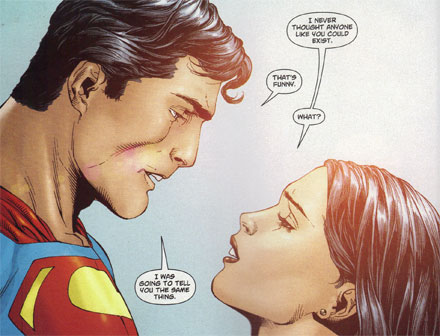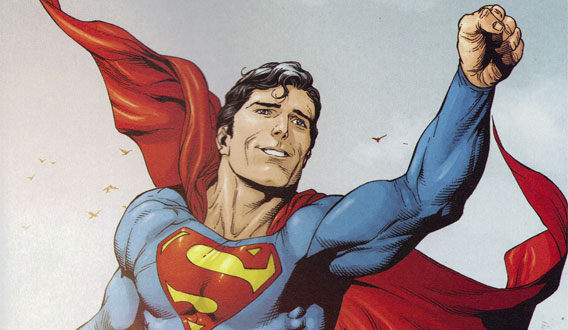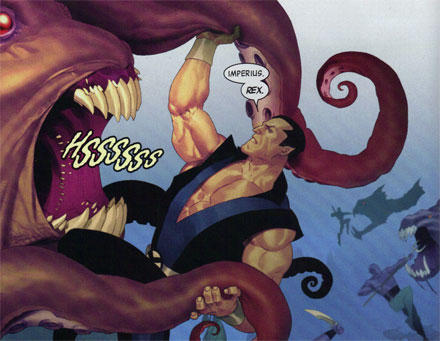This is what happens when Techland goes to the comic book store: we end up talking about what we picked up. This week, Douglas Wolk, Evan Narcisse, Mike Williams and Graeme McMillan discuss Superman: Secret Origin #6 and Namor: The First Mutant #1.
DOUGLAS: I like the team of Geoff Johns and Gary Frank a lot; I think they bring out a lot of virtues in each other. (Johns gets a very strong visual storyteller to get his beats across with maximal clarity; Frank gets a writer who can play to his knack for character acting.) If Superman: Secret Origin didn’t get up to the dramatic peaks of “Superman and the Legion of Super-Heroes”–still their best collaboration, I think–they did pretty well at putting together the How Superman Got Started story for a nice standalone volume to sell to people who want a meat-and-potatoes Superman book where Lois acts like Lois and Perry White acts like Perry White and so on. That sounds like I’m dismissing it, but I’m not: this issue was a bit of a letdown, but that’s only because the earlier ones hit their marks so deftly.
(More on Techland: The Comic Book Club: The Unwritten and Ultimate Avengers 3)
Here’s my complaint, because I am a complainer: I realize that the ultimate target audience for this thing is people who’ve seen a Superman movie and want to try reading a comic, but more than ever, Frank is drawing Superman as Christopher Reeve in a Superman outfit. In that Superman/Lois near-kiss scene at the end, the coloring approximates lens flare. Comics don’t have lens flare. (Unless their creators go out of their way to put it there.) It’s fine that Johns and Frank have made a comic book whose argument is that comics can do Superman just as well as movies; I think it makes that point pretty effectively. But wouldn’t it be more fun if their argument was that comics can do things with Superman that movies never could?

GRAEME: I have to admit, I think this trumps “Superman and the Legion,” if only because it feels to me that it is less comic-book-nerds-only, while still hitting the essential “this is who Superman is” beats at the right time. You’re right that Johns and Frank bring out the best in each other, but I think Superman does the same for both creators, as well; yes, Superman looks like Christopher Reeve, but this is the best art I’ve seen from Frank maybe ever, and Johns shines when he writes Superman. It brings out a hidden vein of sincerity and optimism that doesn’t have the “THIS IS EPIC” self-consciousness of something like, say Blackest Night or Green Lantern. Despite the scale of the plots, his Superman always feels wonderfully human to me, if that makes sense.
(More on Techland: The Comic Book Club: Wonder Woman and Action Comics)
MIKE: You think the target audience for this book is the Superman fan who is new to comics? I hadn’t looked at it like that. I took it as another “What If” story, even if this is now supposed to be the definitive origin story for Supes. I thought the whole thing was for longtime Superman fans that are well versed in Kryptonian lore. And yes, that is Christopher Reeve (if he were ripped to shreds).

DOUGLAS: Apparently the previous how-Superman-got-started book (Mark Waid and Leinil Francis Yu’s Birthright) did particularly well as a trade paperback; the question the new customer always asks is “where do I start?” Johns is a smart writer, and one of the things he’s smart about is providing an on-ramp; every time he introduces a character here, he introduces that character. I think there are a ton of Easter eggs here for longtime Superman fans, but it seemed to me like the way this one was meant to be experienced was as a book, and a book bought at a bookstore rather than at a comics store, if that distinction makes sense.
MIKE: Did you not read Birthright? I think it’s superior. And yes, buying this as a trade makes much more sense, especially considering that the shipping schedule was bimonthly at best. If I worked at a shop and someone asked me where should I start with Big Blue, I don’t know if I could have said pick up the first three issues of Secret Origin and then come back in two months.
DOUGLAS: I read and enjoyed Birthright enormously!
I mean, I’d say “just buy All Star Superman,” but that’s what I say for everything right down to “what shall we have for breakfast?”
GRAEME: To be fair, All Star Superman tastes GREAT with milk.
I really love Birthright, maybe more than Secret Origin, but I think SO feels more like a story that fits into the DC Universe as we know it, as opposed to Birthright which could’ve/should’ve been a Superman movie, divorced of everything outside of itself. I’m not sure if that really counts, its adherence to a greater continuity, but it’s definitely there.
MIKE: Well, that’s the issue, right? Isn’t Secret Origin being billed as the official story now?
GRAEME: Yeah, Secret Origin is THE ORIGIN. I seem to remember Birthright being contradicted in the regular books as it was coming out, but I may be wrong.
EVAN: The most interesting thing about this tug-of-war between interpretations of Superman is that I don’t think Johns’ and Waid’s takes are all that different. Waid leans a bit more on the lonely outsider stuff in Birthright and does a way better job of giving Superman something to pine away for, in terms of glimpsing Krypton. Johns uses Superman as someone who stands for the best of us, almost all the time.
The artists in both stories impact the way they hold up, too. Frank is just a better storyteller than Yu. And the action stuff in this issue of Secret Origin is great. You feel like Superman’s at risk here, even though you know he’s not.
Ultimately, I’d hand this to a newbie or lapsed comic reader before anything JMS has done. There is some self-consciousness in it–you can see Johns’ vision of the character peeking through when Superman speechifies–but it’s less off-model than JMS’s issues have been so far.
DOUGLAS: On to Namor: The First Mutant #1. I suppose gerrymandering the Sub-Mariner in as an X-book is an approach that hasn’t been tried before (although I kind of think of all the “Curse of the Mutants” stuff as an off-label sub-category of the X-books). And I like Ariel Olivetti’s artwork, here as in his run on Incredible Hercules; it reminds me a little of those early-’80s magazine-sized Marvel titles where they were all excited about how the artwork was painted like, you know, real art, and also of the stuff Frazer Irving’s been doing lately.
What I don’t know about, honestly, is trying to give Namor his own book again. This is something like Marvel’s sixth attempt at a Sub-Mariner ongoing since 1968 (not counting various miniseries and such), and aside from the bizarre Bill Everett run, nobody’s really been able to make him work as a lead character in a long time. Namor’s a great supporting character–the nobleman who’s genuinely noble but also a total dick, the champion of his realm who cares so little for anybody else’s that he can seem to be a hero or a villain by surface-world standards at any point but never actually changes his mind. But all that has to do with how he plays off protagonists; I don’t know that he’s as effective as one (even though the “being a dick to the soothsayer” scene at the beginning of this is entertaining).
(More on Techland: “Batwoman: Elegy” and “Werewolves of Montpellier”)
Really, the best thing about this issue is Jae Lee’s cover: Namor perched in one of those crossed-ankled positions that you can do underwater but not on the surface, giant symmetrical squid-creature behind him, two little trails of blood rising from his neck. That’s an arresting image.
EVAN: I already think that this story would be best kept to a miniseries. A few things struck me about this issue:
New status quo aside, I really don’t like the big red X on Namor’s belt. I know what it stands for, but we’ve got a character who’s always been cantankerously his own man. The X feels like it’s diluting Namor.
Olivetti’s art works great underwater. He’s never been one for backgrounds, so undersea stuff is awesome for him.

I generally like Moore’s work–his Firestorm run is one of the best teenage-superhero comics in ages–but this issue felt way overwritten. The book starts with a creepy horror tone, but everybody then starts talking too much. And I’ve really grown to hate these text pieces at the back of milestone issues. If you can’t tell me everything I need to know about the character in the panels, then something might be wrong.
I love Namor as a character. I do. But the whole dominance of Namor-as-asshole meme over the last few years is as bad for him as the self-destructive Matt Murdock thing has been in Daredevil. I kinda want a more thawed-out Avenging Son. I hope Moore brings him there.
(More on Techland: The Comic Book Club: X-Men, Superman and Parker)
GRAEME: As one who hasn’t read the book thanks to Diamond screwing the West Coast, I really shouldn’t say anything, but I’m very much with you, Douglas, about the wisdom of giving Namor his own book again, especially trying to tie it so closely to the current X-Men vampire storyline (and, for that matter, the character so closely to the X-Men in general). Namor, like Aquaman, just doesn’t seem to work out longterm as a leading man, nor in teams. He’s best as a jerk – occasionally a jerk with the best intentions, or for the right reasons, sure, but a jerk nonetheless – who doesn’t have to shoulder the audience’s attention for too long.
MIKE: Aside from the fact that nothing really happens in this book, I was excited and then let down by the artwork of Olivetti. The problem with drawing a story about characters diving “below the sea floor” where it’s so dark that vampires flourish is that it’s too dark to show anything. If you just opened this book to any random page, you’d think it took place right off the beach in the Carribean it’s so bright and blue. And that’s just in the panels where the background isn’t pure white. The tone just felt off to me.
DOUGLAS: Weirdly, I’ve recently reread two other stories involving underwater vampires: the Alan Moore “Swamp Thing” story where the community of vampires sets up shop in a stagnant lake, and (especially) that awesome Devlin Waugh story “Swimming in Blood,” with the underwater maximum-security prison and the ultra-dandified Vatican investigator who gets turned into a vampire halfway through the story but that doesn’t even faze him, he just starts taking bottles of blood with him everywhere he goes along with his Oscar Wilde first editions and ancient Persian rugs.
GRAEME: I love Devlin Waugh. John Smith really is an incredibly underrated writer.

